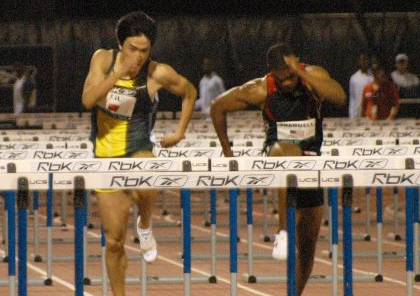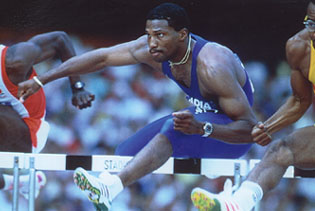In the 110/100 meter hurdles, we all know how important it is to get out with a good start and put pressure on your opponents to come track you down. A good start puts you into a good rhythm, and we all know that opponents are more likely to make technical mistakes and hit hurdles if they are running from behind than if they are running in front. But many a great race has been run from behind, including Liu Xiang’s 12.92 at the Reebok Invitational in New York a week ago – the performance that inspired me to write this article. In this article I want to talk some about hurdling from behind – how to do it, who does it well, and what we can learn from those who do it best.
What is “Speed” in the Hurdles?
In The Science of Hurdling, Canadian coach Brent McFarlane writes, “Most hurdlers take 8 strides to the first hurdle and 3 strides between hurdles. As a result, the stride length and number of strides are controlled. Stride frequencey is therefore the determining factor of speed in the event.” That Liu Xiang walked down Terrence Trammell – the fastest 100m sprinter among all current hurdlers – has many in the track world shaking their heads and asking themselves, how did he do that? How could anybody walk down Terrence Trammell, who not only can, but actually has run under 10.10 in the open 100? And how could anybody walk down Trammell when he’s running a 12.95? A personal best? One of the fastest times ever?
Well let me put it to you this way. Firstly, someone with Trammell’s speed can never use his speed fully in a 110m hurdle race. Much of his speed is negated by the height of the hurdles and the small amount of space between each one. A sprinter like Trammell cannot open up and truly sprint the way he wants to because, if he did, he’d be crashing into hurdles constantly.
So, if Coach McFarlane’s observation is to be taken to heart, then speed in the hurdles is a matter of stride frequency, or quickness. And Liu Xiang has very quick feet. He’s got very low knee-lift in his three strides between the hurdles, and very low arm carriage. Then his hurdle clearance features a lightning-quick lead leg followed by an equally quick trail leg. In the hurdles, the fastest hurdler is not the fastest sprinter, but the one who can best adapt his speed to the rhythm of the race. Former hurdling great Renaldo Nehemiah, whose face appears on every page of this website, once told me in an email that he used to intentionally zigzag in the lane, trying to give himself more room to sprint.

Xiang and Trammell battle it out at the Reeobok Invitational in New York.
Do the First Five Hurdles Even Matter?
Of course they do, but I’m one who feels that the start, and the first half of the race in general, is over-emphasized, and that the latter part of the race is de-emphasized by many coaches. To put it simply, the sooner you reach top speed, the sooner you will begin to decelerate, and the longer the deceleration phase of your race will be. Think of it in sprinter terms: If you’re already at top speed by the 30m mark, you’ll begin decelerating by 60m mark, whereas someone who reaches top speed at the 50m mark won’t begin decelerating until the 80m mark.
In the hurdles, there’s something that exists that I call the “fifth hurdle phenomenon.” I can’t explain it, and I can’t claim to know what causes it, but I know it’s real. Ron Bramlett talked about this when I interviewed him for the profile I did on him a while back. At hurdle five, the better hurdlers just suddenly, and effortlessly, surge. They create separation from the pack and, if anyone’s in front of them, they begin to track them down. All the best modern hurdlers have this ability to ratchet up the speed in the second half of the race. Xiang, Trammell, Allen Johnson, Dominique Arnold, Dayron Robles, Ladjii Doucoure when he’s on his game – all these guys have this phenomenal ability to shift into another gear at hurdle five. It’s almost like in a basketball game, where the teams are tied at half-time, and then the better team just takes over and asserts its will in the third quarter.
How to Hurdle from Behind
Hurdling from behind is an art unto itself. The immediate reaction to falling behind is to press. But when you press, you lose your rhythm, you get on top of hurdles, you hit hurdles. The basic instinct when you’re behind is to run faster. The problem with following that instinct in the hurdles is that it causes you to take longer strides, which causes the crowding issues. So the key to hurdling from behind lies in being able to quicken your strides without lengthening your strides. That’s a very difficult thing to do. It requires a lot of mental discipline and an unwavering faith in your ability to come back. A 10-hurdle race is a long race. A lot can happen, both good and bad. But nothing good can happen if you don’t keep your composure. So, when you fall behind, train your mind to think, “quicker quicker quicker!”, not “faster faster faster!”, and you should be able to make up some ground.

Roger Kingdom – one of the best ever at hurdling from behind.
The Will to Win
The will to win is as important in hurdling as it is in any other event, or any other sport. Sometimes a hurdler has to go into what I call “bump it mode.” Actually, I use a different four-letter word, but you know I gotta keep it clean on the website. “Bump it mode” is when you say to yourself, in the midst of a race, “Bump it, I am not going to lose this race,” and you just find it within yourself to come back and win. When you’re in that mode, you’re not thinking about lead leg or trail leg or your lean. Technique goes out the window. Your total focus is just on winning the race.
That type of will to win is what Xiang demonstrated when he walked down Trammell, and, to a lesser degree, when he caught Dominique Arnold at the tape in the 12.88 world record race last year. Arnold was not ahead by as much as Trammell, but he did lead a good chunk of that race. In both cases, Xiang kept his composure, quickened his tempo, and then just decided he was not going to lose. It’s pretty awe-inspiring when you think about it.
Nehemiah did the same thing in his 12.93 world record race back in ’81. Greg Foster was ahead at the third hurdle, running the race of his life. Then Renaldo just found another gear. You could almost see Renaldo think to himself, “Bump it, he’s not going to be beat me.” It wasn’t the most technically sound race he ever ran, but the will to win can often overcome technical flaws.

Renaldo Nehemiah gains the slightest edge over rival Greg Foster in Nehemiah’s 12.93 WR race in Zurich, in 1981.
One of the best I ever saw at hurdling from behind was two-time Olympic champion Roger Kingdom. This wasn’t always a good thing because it often meant that he had spent the early part of the race smashing hurdles. But Kingdom could make up ground on the ground like no one I’ve ever seen.
Final Thoughts
So all you young hurdlers out there, get your cardio in during the off-season, get your hurdle reps up during the pre-season, do your interval workouts even if they’re tiring and tedious. If you want to be reach your potential as a hurdler, you have to be able to run the second half of the race without fading, but with the same aggression that you run the start of the race.
